Corn Ear Molds
BY Dairyland Seed Agronomy Team
While out walking fields and examining ears you might notice a common sight of western bean cutworm or corn ear worm feeding. Ears damaged by insect pressure, coupled with recent wet weather in some areas, can increase the potential for ear rots to set in. Some of these ear rots are capable of producing mycotoxins and Table 1 gives a quick reference for which common ear rots have the potential for mycotoxin development. This is more of something to keep an eye on rather than something to sound the alarm about. Since silage harvest is getting closer it is a good idea to scout your fields so there are no surprises at harvest.
Table 1. Common Ear Molds in Corn |
||||
|
Disease |
Diplodia |
Gibberella |
Fusarium |
Aspergillus |
|
|
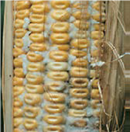 |
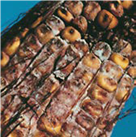 |
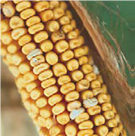 |
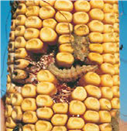 |
|
Favorable Environment |
Warm, moist conditions during silking |
Cool, moist conditions during silking |
Hot, dry conditions and damaged ear |
Hot, dry conditions and damaged ear, especially during pollination |
|
Mycotoxin Potential |
No |
Yes |
Yes |
Yes |
Diplodia Ear Rot
Diplodia Ear Rot, Stenocarpella maydis, is easily identified by its white-to-grayish-brown mold growing on and between the kernels of the ear. The mold usually starts at the base or in the middle of the ear and progresses to the tip. Diplodia ear rot can also be identified from the outer husk of the ear. You can often see black specks scattered on the husks. The specks are pycnidia, the spore-producing structures of the fungus. Pycnidia overwinters on corn debris and become the source of the infection the next year.
Often times the ears are infected with this particular ear mold as soon as 21 days after silking, a stage where the ear is very susceptible to infection. Since the pathogen overwinters on corn debris, no-till corn-on-corn situations are at a higher risk for infection. Dry conditions prior to silking and wet conditions after silking are also very favorable for disease development. Tillage or rotation away from corn will help reduce Diplodia in the soil. Diplodia impacted grain can have lower test weight and in severe cases can cause storability issues.
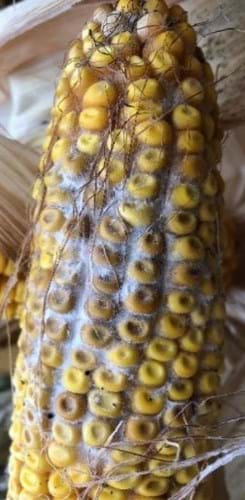
Giberella Ear Rot
Giberella Ear Rot, Giberella zeae, is most easily identified by its pink or reddish color and “fuzzy” fungal bodies on and between kernels. The infection begins at the tip and moves towards the base. Infection generally occurs during cooler periods, 2-3 weeks after silking. Giberella over winters in corn residue as well as wheat residue that was infected with Fusarium Head Blight, which is the same pathogen. Large scale infections of Giberella can cause grain quality issues by producing mycotoxins such as Deoxynivalenol or DON and vomitoxin. These mycotoxins can cause issues when fed to animals, especially swine. Testing of suspect grain is preformed to determine levels of DON.
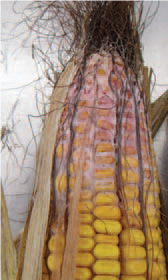
Fusarium Ear Rot
Fusarium Ear Rot, Fusarium verticillioides, looks different from the other two rots mentioned above. Fusarium infects the corn ear in patches or on single kernels and tends to show up more often when there is damage to the kernels caused by hail, insects or birds. The kernels turn tan or brown and the mold appears to be white, gray or pink in color. The symptoms on the kernels typically begin as white streaks called “star bursts” where the mold grows under the seed coat. Infection is more severe during warm and dry conditions.
Fusarium Ear Rot is caused by three species of fungi. Two of the species can cause fumonisins, a group of mycotoxins that affect humans and livestock. Since the three fungi exhibit similar symptoms, a lab test is needed to properly identify the infecting fungus. If there is potential for fumonisins, then you should follow recommendations for harvesting and handling contaminated grain.
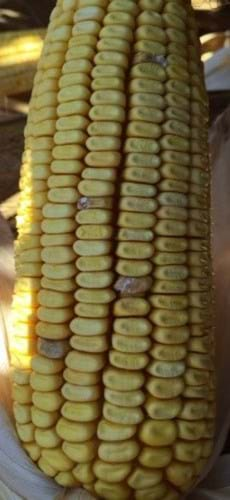
Aspergillus Ear Rot
Aspergillus Ear Rot, Aspergillus flavus, is identified by powdery olive-green fungal structures often accompanied with white or black structures as well. Hot and dry growing conditions with otherwise stressed plants, favor infection. Aspergillus creates a mycotoxin in the kernel called aflatoxin. Aflatoxin is harmful can cause a number of health issues for animals if large amounts of grain are infected. Stress mitigation through proper fertility as well as drought tolerant hybrid selection can help reduce chances of infection.
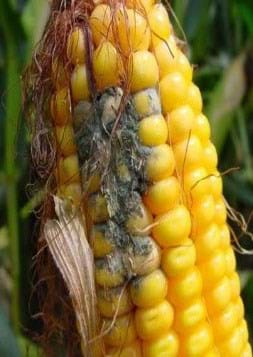
The information in this article is not meant to incite fear, but instead be a guide to help recognize ear molds and potential problems if they appear in your field. If you have any questions please contact your Dairyland Seed DSM or Regional Agronomist.
 |
 |
 |
 |
 |
| Brian Weller Western Region 507.456.3034 |
Dan Ritter Central Region 219.863.0583 |
Branden Furseth Northern Region 608.513.4265 |
Mark Gibson Eastern Region 260.330.8968 |
Amanda Goffnett Eastern Region 989.400.3793 |
